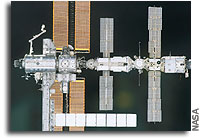ISS Science Operations Status Report 9 Jan 2003

Remotely operated science combined with the human touch got the second Zeolite Crystal Growth (ZCG) experiment off to a good start during the past week.
On Friday, January 3, Expedition Six Commander Ken Bowersox unloaded samples completed two days earlier from the zeolite experiment and reconfigured the furnace for another round of tests. After twirling each of the 19 new sample tubes to reduce the number of bubbles in them, he installed the samples in the ZCG furnace to begin a scheduled 15-day processing run.
On the ground, the Center for Advanced Microgravity Materials Processing at Northeastern University, Boston, Mass. transmitted commands to initiate sample mixing. When one sample appeared to jam, Bowersox used a hand drill instead to mix the sample and begin processing.
“The autoclave malfunctioned due to the particular sand-like nature of the mixture,” said Expedition Six Lead Increment Scientist Vic Cooley. “Although this experiment is controlled from the ground, Ken Bowersox’s ability to intervene, assess the problem and take corrective action enabled the science team to begin processing all of their samples. It’s also a good example of how humans in space and humans on the ground can work together to achieve more than they could separately.”
Zeolites are used in many manufacturing processes on Earth. Virtually all the world’s gasoline is produced or upgraded using zeolites. Improving zeolites could make gasoline production more efficient or lead to ways of storing clean-burning hydrogen for fuel. Zeolites can also be applied to detergents, optical cables, gas and vapor detectors for environmental monitoring.
The microgravity environment of the Space Station allows scientists to grow higher-quality crystals that are 100 to 500 times larger than normal for analysis and test the crystallization process in “slow motion” without being rushed by the effects of gravity.
On Monday, January 6, Bowersox set up the FOOT/Ground Reaction Forces During Space Flight (FOOT) experiment and conducted the experiment on Tuesday. He transferred the data Wednesday to the HRF laptop computer for downlinking later. FOOT is designed to characterize the stress on the bones and muscles in the lower extremities in microgravity.
On Thursday, all three crewmembers participated in the Pulmonary Function in Flight (PuFF) experiment. The PuFF session will serve double-duty as both a monthly and a pre-spacewalk test. PuFF focuses on lung function both following spacewalks and during long stays in microgravity – laying the groundwork for future experiments which are key to understanding and maintaining crew health.
The crew during the week also continued to perform daily status and maintenance checks on Space Station science payloads and equipment. They are continuing to participate in the Renal Stone experiment, in which they take potassium citrate or a placebo pill as a possible preventative for kidney stone formation in microgravity.
The Space Acceleration Measurement System (SAMS) and the Microgravity Acceleration Measurement System (MAMS) continue to collect acceleration data to characterize the microgravity environment of the station necessary for planning future microgravity experiments.
The Protein Crystal Growth-Single Locker Thermal Enclosure System (PCG-STES) experiment continues to function normally in its automated mode. The passive Materials ISS Experiment (MISSE) is also in progress and scheduled to be retrieved for return to Earth during Expedition Seven.
Crew Earth Observation photography subjects this week included: the Strait of Hormuz in the Persian Gulf, southwest Libyan geology, southwest Sudan, Lagos, Nigeria, Miami, Florida, Navassa Island in the Caribbean, Caracas, Venezuela, Las Vegas, Nevada, Phoenix and Tucson, Arizona, and the Isla del Coco in Costa Rica.
The Payload Operations Center at NASA’s Marshall Space Flight Center in Huntsville, Ala., manages all science research experiment operations aboard the International
Space Station. The center is also home for coordination of the mission-planning work of a variety of international sources, all science payload deliveries and retrieval, and payload training and payload safety programs for the Station crew and all ground personnel.









